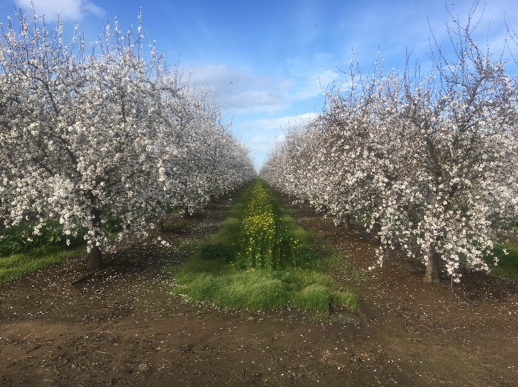Growers who would like to participate in the Seeds for Bees program have until Nov. 1, 2019 to submit their applications.

Seeds for Bees is organized by Project Apis m. (PAm.), one of the nation’s leading honey bee research organizations. The program encourages the planting of bee forage as part of riparian areas or cover crops in and around California orchards, farms and vineyards to increase and provide variance in forage available to pollinators.
Why is forage important?
Planting additional forage is good for bees and good for pollination. Research funded by the Almond Board of California (ABC) shows that supplementary forage does not compete with almond blossoms for pollination and improves bee health, allowing for more robust hives. As the California Fish and Game Commission considers listing native bees under the state’s Endangered Species Act, being a good partner to all bees is in agriculture’s best interest.
In addition to providing food and habitat for bees, Almond Board-funded research shows cover crops also provide other benefits to an orchard by:
- Adding organic matter to soil
- Increasing water infiltration and water-holding capacity
- Reducing erosion
- Providing a natural weed control
- Suppressing parasitic nematodes
- Driving carbon back into the soil
During the 2018-19 Seeds for Bees program, PAm. reported that 149 California almond growers planted 8,005 acres of cover crops in and around their orchards, representing 27 counties throughout California.
“We’re trying to expose this program to more and more growers,” said Billy Synk, director of Pollination Programs at Project Apis m. “We believe there’s more opportunity for cover crops to be utilized, and while we don’t think cover crops are appropriate on every inch of every orchard, they have worked from Bakersfield to Chico. We want to provide the information to help growers make the right decision.”
The Almond Board joins Project Apis m. in its efforts to preserve honey bee health. Last year, the Almond Board updated its Honey Bee Best Management Practices, originally produced in 2014, which provide simple, practical steps that almond growers, together with beekeepers and other pollination stakeholders, can take to protect and promote bee health in and around their orchards, and in their surrounding community. These management practices also include information about the benefits of cover crops where orchard conditions are favorable (see pages 16-17).
“Overall, the indication is that planting additional forage for bees helps pollination,” said Josette Lewis, director of Agricultural Affairs for the Almond Board. “Investing in bee health makes sense in the short term by improving pollination, and in the long term it promotes hive health after the bees leave our orchards. Healthy hives will also help bring down the cost of pollination services in the future.”
To participate in Seeds for Bees, growers can apply to receive seed mixes specifically designed to “bloom at critical times of the year when natural forage is scarce but managed and native bees are active,” according to Project Apis m. There are five different seeds mixes to choose from, each one best suited for specific soil types, climate and nearby crops.
Synk said cover crops should be planted in October and early November in order to help bees during the critical bloom in February. He encourages growers to check out the PAm. website for more information on Seeds for Bees and opportunities to learn more about the value of cover crops, including dates and times for in-orchard cover crop demonstrations being held next spring.


